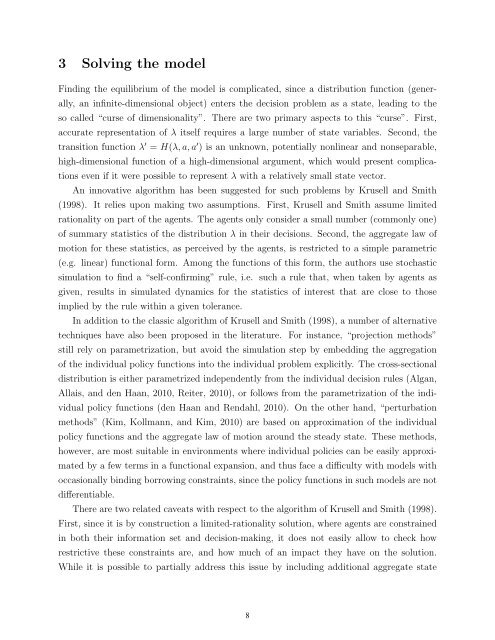You also want an ePaper? Increase the reach of your titles
YUMPU automatically turns print PDFs into web optimized ePapers that Google loves.
3 Solving the model<br />
Finding the equilibrium of the model is complicated, since a distribution function (generally,<br />
an infinite-dimensional object) enters the decision problem as a state, leading to the<br />
so called “curse of dimensionality”. There are two primary aspects to this “curse”. First,<br />
accurate representation of λ itself requires a large number of state variables. Second, the<br />
transition function λ ′ = H(λ, a, a ′ ) is an unknown, potentially nonlinear and nonseparable,<br />
high-dimensional function of a high-dimensional argument, which would present complications<br />
even if it were possible to represent λ with a relatively small state vector.<br />
An innovative algorithm has been suggested for such problems by Krusell and Smith<br />
(1998). It relies upon making two assumptions. First, Krusell and Smith assume limited<br />
rationality on part of the agents. The agents only consider a small number (commonly one)<br />
of summary statistics of the distribution λ in their decisions. Second, the aggregate law of<br />
motion for these statistics, as perceived by the agents, is restricted to a simple parametric<br />
(e.g. linear) functional form. Among the functions of this form, the authors use stochastic<br />
simulation to find a “self-confirming” rule, i.e. such a rule that, when taken by agents as<br />
given, results in simulated dynamics for the statistics of interest that are close to those<br />
implied by the rule within a given tolerance.<br />
In addition to the classic algorithm of Krusell and Smith (1998), a number of alternative<br />
techniques have also been proposed in the literature. For instance, “projection methods”<br />
still rely on parametrization, but avoid the simulation step by embedding the aggregation<br />
of the individual policy functions into the individual problem explicitly. The cross-sectional<br />
distribution is either parametrized independently from the individual decision rules (Algan,<br />
Allais, and den Haan, 2010, Reiter, 2010), or follows from the parametrization of the individual<br />
policy functions (den Haan and Rendahl, 2010). On the other hand, “perturbation<br />
methods” (Kim, Kollmann, and Kim, 2010) are based on approximation of the individual<br />
policy functions and the aggregate law of motion around the steady state. These methods,<br />
however, are most suitable in environments where individual policies can be easily approximated<br />
by a few terms in a functional expansion, and thus face a difficulty with models with<br />
occasionally binding borrowing constraints, since the policy functions in such models are not<br />
differentiable.<br />
There are two related caveats with respect to the algorithm of Krusell and Smith (1998).<br />
First, since it is by construction a limited-rationality solution, where agents are constrained<br />
in both their information set and decision-making, it does not easily allow to check how<br />
restrictive these constraints are, and how much of an impact they have on the solution.<br />
While it is possible to partially address this issue by including additional aggregate state<br />
6<br />
8

















